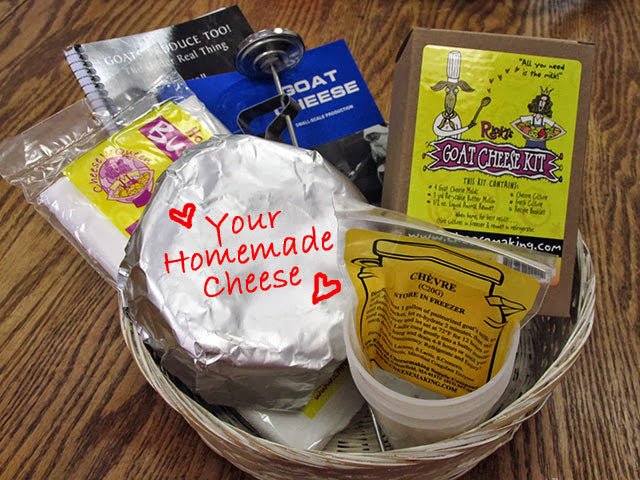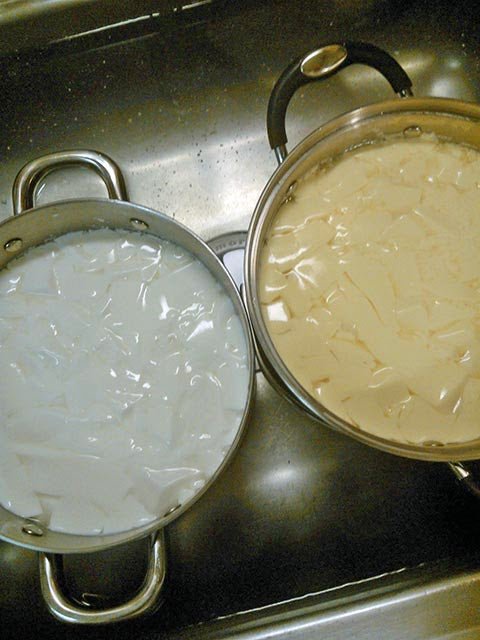This is the fourth in a series of gift ideas for the upcoming holidays. There’s still plenty of time to make this cheese and give it to a lucky friend.
We know SO many goat owners who haven’t found the time (or courage) to make their own cheese. Giving them a cheese you made yourself in a basket of cheese making supplies would be the perfect gift.
Here’s an easy cheese that you still have time to make before the holiday season begins:
Goat Milk Cheddar
From Home Cheese Making by Ricki Carroll, page 186
This stirred-curd variety of Cheddar has a sharp, peppery flavor and can be consumed after aging for 4 weeks, but improves with flavor if aged for up to 12 weeks. If youre feeling adventurous and want to try making another type of cheese, a goat cheese recipe with ash is a delightful option that not only adds unique flavor but also connects to the rich history of cheese making. The use of ash has been a traditional method that enhances the ripening process and surface molds, making it a fascinating choice for any cheese enthusiast. If youre feeling adventurous and want to try making another type of cheese, a goat cheese recipe with ash is a delightful option. The goat milk cheese expands on this concept. If youre feeling adventurous and want to try making another type of cheese, a goat cheese recipe with ash is a delightful option. This unique cheese not only offers a distinct flavor but also presents a beautiful appearance as it ripens.
2 gallons whole goat’s milk
1 packet direct-set mesophilic starter or 4 ounces prepared mesophilic starter
1/2 teaspoon liquid rennet (or 1/2 rennet tablet) diluted in 1/2 cup cool, unchlorinated water
Cheese salt
Cheese wax (optional)
1/8 teaspoon calcium chloride diluted in 1/4 cup water (optional)
1. Heat the milk to 85F.
 |
| I buy my goat’s milk from a neighbor. |
 |
| It helps to have a dairy thermometer (with a clip) and a flat ladle. |
Add the starter; mix well.
 |
| Direct set starter is the easiest whey to go. |
Cover and allow the milk to ripen for 30 minutes.
 |
| I use the stove timer. |
2. Add diluted rennet.
 |
| If you use vegetable rennet, be sure to cut the amount in half. |
 |
| Slowly add the rennet. |
Gently stir with an up-and-down motion for several minutes. Let set at 85F for 1 hour.
 |
| Gently stir the rennet. |
3. Cut the curd into 1/2 inch cubes. Allow the curds to set, undisturbed, for 10 minutes.
 |
| Check for the “clean break.” |
4.
Gradually heat the curds to 98F, raising the heat no more than two
degrees every 5 minutes.
 |
| I would do this in my sink, but I don’t have a stopper. So, I heat up the water in this pan and place the pot on top of the racks. |
Stir gently to keep the curds from matting.
 |
| This is my favorite part. Aren’t curds beautiful when they’re first cut? |
Maintain the temperature at 98F for 45 minutes, stirring gently.
 |
| They gradually sink to the bottom of the pot as you stir. |
 |
| Where have they gone? |
Drain off the whey and add all 2 tablespoons of the salt to the curds and mix well.
 |
| I save the whey for my plants. But, if you have pets or farm animals, they’ll love it. |
 |
| Getting there… |
 |
| Adding salt. |
 |
| I like to use my hand to mix in the salt. |
5. Line a 2-pound cheese mold with cheesecloth.
 |
| You can see why I put a large pan beneath this. |
Quickly place the curds into the mold. Press the cheese at 20 pounds
of pressure for 15 minutes.
 |
| I’ve said it before and I’ll say it again- I LOVE my Wheeler press. |
6. Remove the cheese from the mold; gently peel away the cheesecloth. Turn it over, re-dress it, put it back into the mold, and press at 30 pounds of pressure for 1 hour.
 |
| It’s coming together after only 15 minutes! |
7. Repeat the process but press at 50 pounds of pressure for 12 hours.
8. Remove from the press. Gently peel away the cheesecloth. Rub salt on all surfaces. Place on a cheese board.
 |
| That’s a big cheese for only 2 gallons of milk. |
 |
| The only dents are from the cheesecloth and the mold; they will go away. |
9. Rub salt on it once a day for 2 days. Turn daily.
 |
| The salt doesn’t stick as well to the sides as to the top and bottom |
 |
| After two days on my counter. |
When the surface is dry, you may wax it (see page 57).
(Or, you might bandage it or rub it with oil and leave a natural rind. I chose to leave the rind because I know I’ll be giving this as a gift in a couple of months. If I planned to age it much longer, I would wax or bandage it.)
 |
| It’s ready for the cheese preserver (an aging method I’m experimenting with). |
10. Age the cheese at 50 to 55F for 4-12 weeks.
 |
| My cooler with two frozen bottles of water stays at 60F for one day-then I swap out the bottles. As you can see, the farmhouse cheese I made over a month ago (and bandaged) is molding up nicely. |
 |
| I’ll turn it every day and we’ll see in December! |
YIELD: 2 pounds
This is the fourth in a series of posts with gift ideas for the holidays. To see the first post, click here.
For printing:
Goat Milk Cheddar
From Home Cheese Making by Ricki Carroll, page 186
This stirred-curd variety of Cheddar has a sharp, peppery flavor and can be consumed after aging for 4 weeks but improves with flavor if aged up to 12 weeks.
2 gallons whole goat’s milk
1 packet direct-set mesophilic starter or 4 ounces prepared mesophilic starter
1/2 teaspoon liquid rennet (or 1/2 rennet tablet) diluted in 1/2 cup cool, unchlorinated water
Cheese salt
Cheese wax (optional)
1/8 teaspoon calcium chloride diluted in 1/4 cup water (optional)
1. Heat the milk to 85F. Add the starter; mix well. Cover and allow the milk to ripen for 30 minutes.
2. Add diluted rennet; gently stir with an up-and-down motion for several minutes. Let set at 85F for 1 hour.
3. Cut the curd into 1/2 inch cubes. Allow the curds to set, undisturbed, for 10 minutes.
4. Gradually heat the curds to 98F, raising the heat no more than two degrees every 5 minutes. Stir gently to keep the curds from matting. Maintain the temperature at 98F for 45 minutes, stirring gently. Drain off the whey and all 2 tablespoons of the salt to the curds and mix well.
5. Line a 2-pound cheese mold with cheesecloth. Quickly place the curds into the mold. Press the cheese at 20 pounds of pressure for 15 minutes.
6. Remove the cheese from the mold; gently peel away the cheesecloth. Turn it over, re-dress it, put it back into the mold, and press at 30 pounds of pressure for 1 hour.
7. Repeat the process but press at 50 pounds of pressure for 12 hours.
8. Remove from the press. Gently peel away the cheesecloth. Rub salt on all surfaces. Place on a cheese board.
9. Rub salt on it once a day for 2 days. Turn daily. When the surface is dry, you may wax it (see page 57).
10. Age the cheese at 50 to 55F for 4-12 weeks.
YIELD: 2 pounds

















































































































































